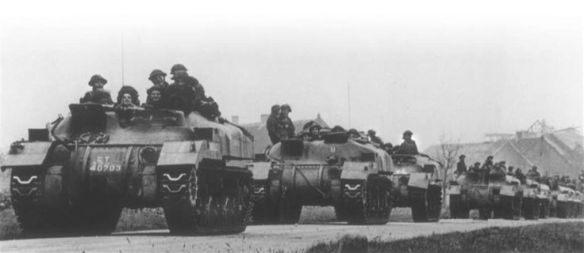Soldiers of the 53rd Infantry Division (Welsh) on the outskirts of Caen in their Kangaroo personnel carriers.
Kangaroos first came into existence for Operation Totalize, which carried over into Operation Tractable, but it was always realised that the Priest Kangaroos would have to be returned to the Americans. Consequently if the Kangaroo concept was to be carried further other vehicles would have to be converted, and a stronger organisation set up for a unit to operate them.
Both these requirements were met by the Canadians, who set up the 1st Canadian Armoured Personnel Carrier Squadron – this would soon become a regiment – and started converting Ram tanks.
The Ram was the Canadian Cruiser. It was a good tank but its turret was too small to mount a 75mm in comfort and its production was halted in favour of the Sherman. But the production was not wasted and the Ram hulls were put to a number of uses, Kangaroos being but one. The Ram was lighter than the Priest and the other tanks in service; the Churchill, Cromwell and Sherman. It was also smaller and could carry no more than an infantry section, ten men if at full strength.
The Canadian Ram unit was the only such unit until December. Up till then, during the great pursuit through France and Belgium, there had seemed little point in creating another, but once the fighting had bogged down, literally, this view changed. 49 RTR was converted to a Kangaroo regiment and renamed 49th Armoured Personnel Carrier Regiment. At roughly the same time the Canadian regiment dropped the word ‘Personnel’ from its title. These seemingly pointless changes to regimental names may hint at a deeper meaning. The Canadians were keen to present the Kangaroos at fighting vehicles, not just busses, whereas the British change hints at down-grading from ‘Tanks’.
Both the British and the Canadian regiments became a part of the 79th Armoured Division. These new regiments were organised as two squadrons of 53 Kangaroos each so, equating a Kangaroo to an infantry section each regiment could carry two battalions.
The creation of the British regiment was in time for the assault of Blerick. After this, up to the end of the war in North-Western Europe, the British regiment was employed in transporting troops of six infantry divisions, one airborne division, an armoured brigade and an armoured division. With switching around like this it is not surprising that tactics for Kangaroos developed slowly. The infantry divisions regarded them merely as armoured lorries, and the occasional attempt to use them more imaginatively could result in disaster.
One such disaster occurred to the east of Cleve during the Reichswald fighting on 12th February 1945. Some Kangaroos had been transporting a battalion of Seaforth Highlanders, after the troops had debussed the Kangaroos were ordered to advance in front of them. They drove into the field of fire of a self-propelled gun and several were knocked out (see note).
Even worse, on 30th March, a Kangaroo squadron working with 53rd Division ran into an AT screen and lost eight Kangaroos. But these cases were exceptions, in general the Kangaroos speeded up infantry operations and increased flexibility. Of greater interest were operations carried out in the last weeks of the war in support of armoured formations.
On 28th March, while the bulk of the Kangaroos were with infantry divisions one squadron was supporting 7th Armoured Division. Following a hard fight at Stadtlohn the Kangaroos and 1RTR staged a six mile breakthrough to Heek. On 1st April they covered 20 miles to Metelen. The infantry, 1/5th Queens, found the Kangaroos dirty, noisy and uncomfortable for long journeys, but safer. After the fighting at Ibbenburen even these distances seemed short, but by then the division was coming across only negligible resistance.
Possible the most interesting use of Kangaroos was made by 4th Armoured Brigade, which is not surprising since it was commanded by Brigadier Carver, the youngest brigadier in the army and the future field marshal. The brigade lost an armoured regiment, detached to support an infantry division, but had under command a battalion in Kangaroos and its motor battalion in half-tracks, so it was formed into two tank/infantry battle groups.
In this formation, starting from Rethem on 14th April 1945, it was able to stage a series of outflanking manoeuvres, squadron/company groups leapfrogging past each other. The Germans of 2nd Marine Division fought hard but had no answer to this type of attack.
It must not be forgotten that mechanised formations consume vast quantities of fuel and ammunition, so any advance by one should not be so deep as to present a long and vulnerable flank to enemy counter-attacks which could cut off supplies. Considering this, perhaps the best employment of tank/infantry battle groups is a series of break throughs, as is illustrated by the 78th Division in the Argenta Gap battle.
As can be seen the British army did not fully exploit the potential of the Kangaroo, which was a pity.
Note
This action is a little difficult to understand, even the number of Kangaroos knocked out varies sharply between various accounts, the number of vehicle casualties and sources of information being:
Three, ‘Through Mud and Blood’, B Perret, London, 1975
Four, ‘6th Guards Tank Brigade’, P Forbes, London, no date
and The Battalion War Diary, TNA WO171/5270
Seven ‘The Story of the 79th Armoured Division’, July 1945.
